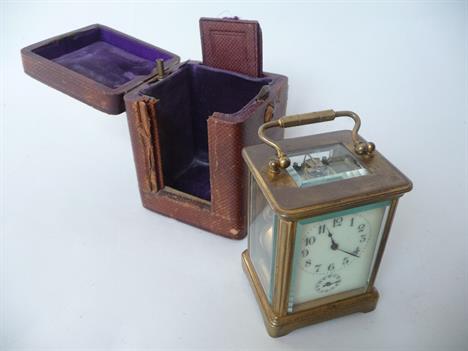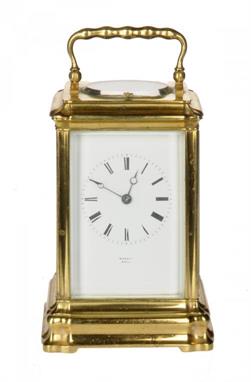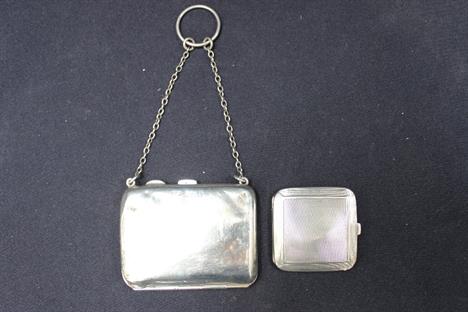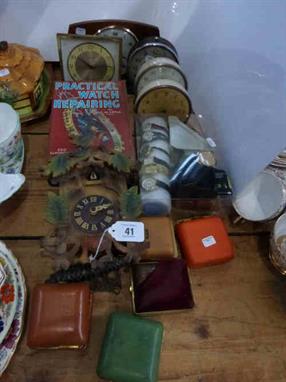We found 5147 price guide item(s) matching your search
There are 5147 lots that match your search criteria. Subscribe now to get instant access to the full price guide service.
Click here to subscribe- List
- Grid
-
5147 item(s)/page
A 1930's Jaeger LeCoultre travelling clock/barometer with central thermometer panel contained within a crocodile effect brown leather case, stamped "Made in France, Patent Applied For", 14.5 cm wide CONDITION REPORTS Cannot guarantee whether in working order, however, thermometer appears to be showing approximately the right sort of temperature and currently reads rain change/fair on the weather side today (which does correspondent to today's weather). Clock is not working at the moment, but is not wound. The clock and thermometer are both dirty and have some surface scratches but overall seem reasonable. The leather case shows signs of wear throughout with some surface scratching and slightly discoloured along the folding side, and towards one edge. The front opening flap - one corner has an area of leather missing about 0.5 x 0.5cm and the leather is worn on the other top corner and there are three blobs of discolouration, two on one corner and one on the other. Overall in used and worn, but well cared for condition.
A Ulysse Nardin deck watch chronometer, MOD issue, the enamel dial and movement signed and numbered 19860, in a silver case, and mahogany travelling box, inset with a Nardin ivorine plaque numbered to match the watch, 10 cm wide See illustration Condition report Report by MW Please note that Charterhouse do not guarantee the working condition of any watch or clock. The outer wooden case has general knocks, bruises etc of general wear. The inner brass mount for the timepiece has general wear, and is tarnished. The dial of the timepiece is in good condition, without visible cracks or chips. The movement is running, no guarantee implied or given.
A FRENCH BRASS CARRIAGE CLOCK the white enamel dial signed below the chapter ring ROLLIN PARIS, the movement with nickel plated platform lever escapement and striking on a bell, the signature repeated on the backplate and numbered 958 in gorge case with repeat button in the top, 13.5cm h excluding handle, late 19th c In restored/overhauled condition, running when wound with a reconditioned travelling case
A late 19th century French repeating carriage clock, with a 6cm white enamel dial signed G P Wehlen and Co, with a platform lever escapement, with repeat striking on a coil gong, within a architectural case with Greek key handle raised upon a plinth base, 18½cm, with an accompanying letter from a previous owner dated July 25th 02, with a red Morocco leather travelling case with overhead handle number 3680 (illustrated)
A rare French petit sonnerie striking carriage clock with two-plane `chaffcutter` escapement and push-button repeat Paul Garnier, Paris, circa 1840 The eight-day two train movement with two-plane `chaffcutter` escapement and three-arm monometallic balance set between the plates and striking the hours and quarters on a pair of graduated bells mounted to the backplate signed PAUL GARNIER, H`LR DU ROI PARIS towards upper left hand corner and numbered 1183 to centre, the rectangular engine-turned silvered brass Roman numeral dial with radial design to centre within chapter ring and `watered-silk` infill incorporating vacant signature plaque to lower margin and with Breguet style blued steel moon hands, the gilt brass one-piece caddy moulded case with hinged slender baton handle above repeat button mounted within the top glass panel and the rear sliding upwards for winding, on cavetto moulded skirt base with inset rounded angles, (strike train with faults), 14.5cm (5.75ins) high excluding handle; with original leather covered outer travelling case. Paul Garnier is recorded in Allix, Charles and Bonnert, Peter CARRIAGE CLOCKS as born 1801 and receiving Silver Medals in the Paris Exhibitions of 1827, 34, and 39; and gold medals in 1844 and 49. He worked from various addresses at Rue Taitbout, Paris and died in 1869 leaving the business to his son of the same name who was still exhibiting carriage clocks in the Paris Exhibition of 1889. Paul Garnier is generally credited for being the first maker to essentially standardise the `petit pendule portative` which was in effect to become the prototype for the archetypal French carriage clock. The current lot with its `chaffcutter` escapement, engine turned `watered-silk` dial and squat one-piece case with wooden block insert to underside can be firmly identified as a `Series I` carriage clock by Garnier as identified by Allix (see Allix, Charles and Bonnert, Peter CARRIAGE CLOCKS pages 56-7). This clock is rare in that it was made with petit-sonnerie striking and has particularly early use of repeat button set into the top glass of the case.
A Fine gilt brass carriage clock with push-button repeat in elaborate rococo chased case Jules, Paris, mid 19th century The eight-day bell striking movement with platform lever escapement incorporating plain split bimetallic balance with wedge shaped weights and helical balance spring, the backplate stamped JULES, PARIS to lower margin, the rectangular white Roman numeral dial with blued steel moon hands and bearing repeat signature to lower margin, the elaborate case with hinged leafy scroll handle above ogee shaped top applied with crest modelled as a pair of reclining putti flanking a globe above generous scrolling angles applied with further putti and terminating in an elaborate scallop shell centred scroll panel to apron flanked by supports finely modelled as a mermaid and her companion, the sides with conforming scrolls bordering glazed insert, the rear matching the front but with elaborated scroll cast door with hinged clasp, 19cm (7.5ins) high; with a maroon leather covered outer travelling case. An identical escapement to the one fitted to the current lot is illustrated in Allix, Charles and Bonnert, Peter CARRIAGE CLOCKS Their History and Development on page 73 (plate II/47). Allix/Bonnert do not list working dates for Jules however similarities between this escapement and those used by Bolivier are noted suggesting a working date of around 1840.
A rare brass travelling clock case and dial Unsigned, second half of the 18th century, the movement later The current French eight-day backwound movement with platform cylinder escapement, the original 2.25 inch brass break-arch dial with concentric panel and rosette engraved centre within an applied Roman numeral chapter ring with arcaded minute ring and Arabic five minutes, the spandrels with conforming engraved borders beneath arch with applied convex boss decorated with a basket of flowers, the brass break-arch case with hinged carrying handle to the foliate pierced and engraved silk-backed arched top above raised rectangular glazed side panels, on small bun feet, 10.5cm (4.25ins) high. The style of the dial engraving and chapter ring of the current lot suggests that the dial and case are of probable German or Austrian manufacture, and was probably made with a short duration fusee movement with alarm. A similar travelling clock resides in the Metropolitan Museum of Art, New York (accession number 29.52.18, .19).
A French brass petit sonnerie striking carriage clock with push-button repeat Retailed by John Walker, London, late 19th century The eight-day movement ting-tang striking the quarters on two graduated gongs and striking the hour on the larger of the two, with replaced platform lever escapement and stamped with oval DC trademark for Drocourt above number 19 711 to backplate, the rectangular white enamel Roman numeral dial with blued steel moon hands and retail signature JOHN WALKER, 77 CORNHILL, LONDON to lower margin, the bevel glazed gilt cannelee case with hinged carrying handle and STRIKING/SILENT selection lever to underside, 15cm (6ins) high excluding handle; with original leather covered outer travelling case (distressed).
A French gilt brass gorge cased carriage clock with push button repeat Retailed by W. Benson, London, circa 1898 The eight-day gong striking movement with silvered platform lever escapement and stamped with oval trademark for Drocourt and number 33349 to backplate, the rectangular white enamel Roman numeral dial with blued steel spade hands and indistinct retail signature ..W. BENSON, .., LONDON to lower margin, the bevel glazed gorge case with hinged carrying handle and presentation inscription S.M. WHYTE, FROM THE DUKE OF WESTMINSTER, 1898, 12.5cm (5ins) high excluding handle; with a contemporary but non-original leather covered outer travelling case.
A French lacquered and patinated brass carriage clock with push-button repeat and alarm Retailed by S. Wilder and Sons, Kendal, circa 1900 The eight-day two train gong striking movement with silvered platform lever escapement and circular white enamel Roman numeral dial inscribed S. WILDER & SONS, KENDAL to centre and with blued steel spade hands set into a rectangular frosted silvered mask with conforming enamel subsidiary alarm setting dial to lower apron, the bevel glazed case with hinged handle above scallop-edged cavetto cornice and fluted Doric three-quarter columns to angles, on conforming skirt base with small squab feet, 16.5ins (6.5ins) high excluding handle; with original leather covered outer travelling case.
An unusual George III small spring driven alarm timepiece John Monkhouse, London, circa 1760 The five pillar single chain fusee movement with verge escapement and alarm mounted behind the dial sounding on a bell mounted above, the plates measuring 4.25 high and 3 inches wide and applied with dust shutters to top and sides, the single sheet silvered Roman numeral dial measuring approximately 5.25 inches by 3 inches with alarm disc to centre and blued steel hands within chapter ring with Arabic five minutes to outer track, within foliate strapwork engraved spandrels and signed J.n.o. Monkhouse, London to the ogee outline arch above, now mounted on a cavetto moulded mahogany base, 15cm (6ins) high. John Monkhouse is recorded in Baillie, G.H. Watchmakers & Clockmakers of the World as working in London 1756-71. From the evidence of his surviving work, which includes several quarter chiming and musical longcase clocks as well as a miniature grande-sonnerie longcase clock, he was a fine and inventive maker. The current lot was probably designed as a travelling timepiece (a spring-driven alternative to a miniature weight-driven lantern alarm timepiece), and was probably originally supplied with a fitted wooden case for protection whilst in transit.
An Edwardian miniature tortoiseshell carriage clock the eight-day duration timepiece movement having a platform lever escapement and stamped on the backplate with the serial number 2850, the round white enamel dial with black Roman numerals and brass moon hands, the tortoiseshell case with applied decorative silver mounts and standing on silver bun feet, height 7cm (handle down), 8cm (handle up) complete with the original leather travelling case.
A George V Silver Travelling Clock, Elkington and Co., Birmingham 1912, rectangular with bevelled edges, scroll handle and raised upon four cushion shaped feet, the circular dial with Roman numerals, movement marked French Made, 7.5cm high, in a red leather fitted case Clear marks, movement ticks when wound, some tarnishing, typical marks to surface. Case worn but overall fair/good
-
5147 item(s)/page


























































